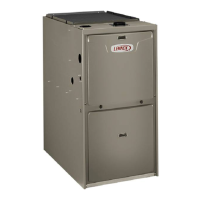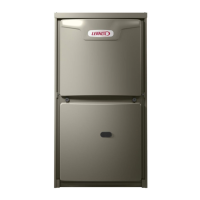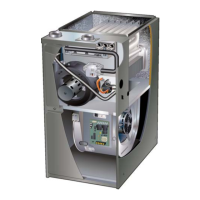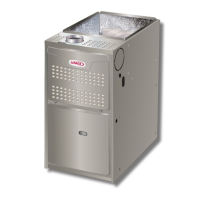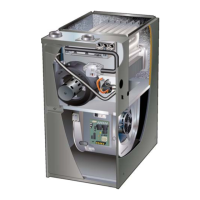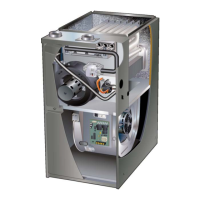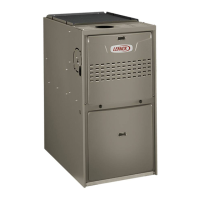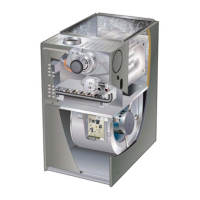Page 24
Resize the common venting system to the minimum vent
pipe size determined by using the appropriate tables in
Appendix G. (These are in the current standards of the
National Fuel Gas Code ANSI Z223.1.
If replacing a furnace which was
commonly vented with another gas appliance, the size
of the existing vent pipe for that gas appliance must be
checked. Without the heat of the original furnace flue
products, the existing vent pipe is probably oversized for
the single water heater or other appliance. The vent
should be checked for proper draw with the remaining
appliance.
REPLACING FURNACE THAT WAS PART OF A
COMMON VENT SYSTEM
CHIMNEY
OR GAS
VENT
(Check sizing
for water
heater only)
FURNACE
(Replaced)
WATER
HEATER
OPENINGS
(To Adjacent
Room)
FIGURE 17
Exhaust Piping (FIGURE 18, FIGURE 20 and FIGURE
21)
Route piping to outside of structure. Continue with instal-
lation following instructions given in piping termination
section.
CAUTION
Do not discharge exhaust into an existing stack
or stack that also serves another gas appliance. If
vertical discharge through an existing unused stack
is required, insert PVC pipe inside the stack until the
end is even with the top or outlet end of the metal
stack.
CAUTION
The exhaust vent pipe operates under positive
pressure and must be completely sealed to prevent
leakage of combustion products into the living
space.
Vent Piping Guidelines
NOTE - Lennox has approved the use of DuraVent® and
Centrotherm manufactured vent pipe and terminations
as an option to PVC. When using the PolyPro® by Du-
raVent or InnoFlue® by Centrotherm venting system the
vent pipe requirements stated in the unit installation in-
struction – minimum & maximum vent lengths, termination
clearances, etc. – apply and must be followed. Follow the
instructions provided with PoyPro by DuraVent and Inno-
Flue by Centrotherm venting system for assembly or if re-
quirements are more restrictive. The PolyPro by Duravent
and InnoFlue by Centrotherm venting system must also
follow the uninsulated and unconditioned space criteria
listed in TABLE 16.
The ML296UHV can be installed as either a Non-Direct
Vent or a Direct Vent gas central furnace.
NOTE - In Non-Direct Vent installations, combustion air is
taken from indoors or ventilated attic or crawlspace and
ue gases are discharged outdoors. In Direct Vent instal-
lations, combustion air is taken from outdoors and ue
gases are discharged outdoors.
Intake and exhaust pipe sizing -- Size pipe according to
TABLE 13 (minimum) and TABLE 14 (maximum). Count
all elbows inside and outside the home. Regardless of the
diameter of pipe used, the standard roof and wall termi-
nations described in section Exhaust Piping Terminations
should be used. Exhaust vent termination pipe is sized
to optimize the velocity of the exhaust gas as it exits the
termination. Refer to TABLE 17.
In some applications which permit the use of several dif-
ferent sizes of vent pipe, a combination vent pipe may be
used. Contact Lennox’ Application Department for assis-
tance in sizing vent pipe in these applications.
NOTE - The exhaust collar on all models is sized to ac-
commodate 2” Schedule 40 vent pipe. In horizontal ap-
plications, any transition to exhaust pipe larger than 2”
must be made in vertical runs of the pipe. Therefore a 2”
elbow must be added before the pipe is transitioned to
any size larger than 2”. This elbow must be added to the
elbow count used to determine acceptable vent lengths.
Contact the Application Department for more information
concerning sizing of vent systems which include multiple
pipe sizes.

